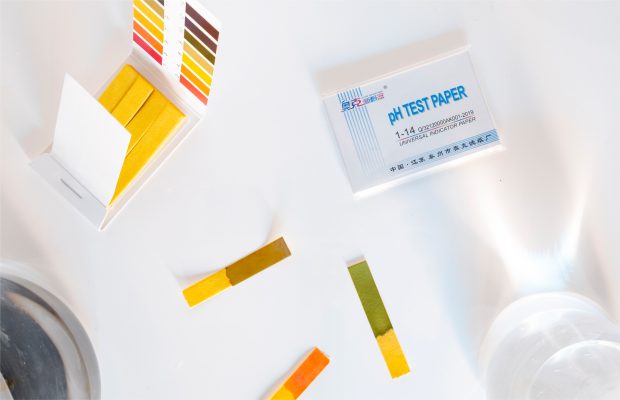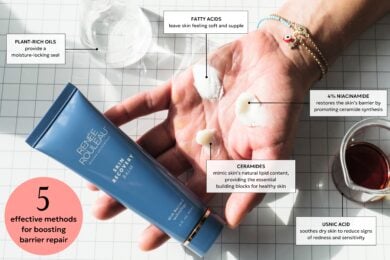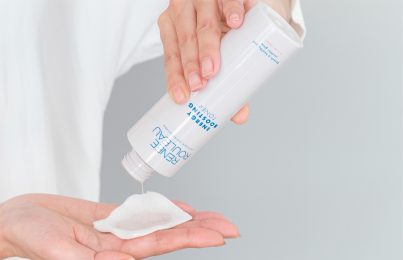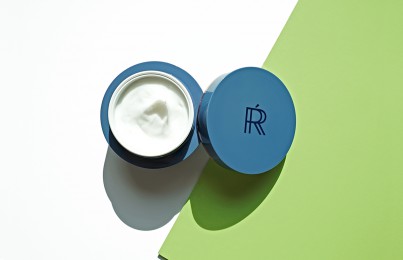Acidic, neutral, alkaline—you may remember hearing these terms in your high school chemistry class, but did you know they apply to your skin as well? Maintaining the right pH level for your skin is essential to a healthy moisture barrier. As a refresher, the moisture barrier is the outermost layer of your skin that helps regulate hydration levels while protecting against harmful bacteria and environmental aggressors.
In this post, I’ll explain exactly how pH level is integral to healthy skin. I’ll also share the three most common ways the pH of your skin can become unbalanced and how to avoid it.
What is the pH Level of Skin?
Since skin is a solid, it doesn’t actually have a pH value. When you hear someone talk about the “pH of the skin,” what they’re really referring to is the pH of the acid mantle. This is a thin, protective film that forms on the skin’s surface and is made up of ceramides and lipids, along with naturally-occurring acids and other chemical compounds secreted by bacteria living on our skin. The acid mantle is just one important layer of the complex ecosystem that forms the skin’s protective moisture barrier.
The natural pH level of our skin is slightly acidic and typically sits somewhere between 4.2 and 6. Most studies have shown that resting, healthy skin has a pH close to 4.7.
What Role Does pH Play in Skin Health?
Maintaining a good pH level for your acid mantle is important because it helps keep the skin in homeostasis. Essentially, it keeps everything balanced so that skin cells have an optimal environment that keeps them functioning in a happy and healthy way.
Our skin’s microbiome is also very much affected by the pH of our acid mantle. Every type of bacteria has an ideal pH range that it lives in, and usually “bad” bacteria can live at a higher pH. So, if we can keep the acid mantle at a pH of around 4.7, bad bacteria can’t grow very well. This also allows the good bacteria that do thrive at this pH to help keep unwanted bacteria in check.
Finally, since a strong acid mantle means a strong moisture barrier, it can help keep your skin healthy by discouraging a number of conditions including dryness, dehydration, irritation, rosacea, and dermatitis.
What Causes the Skin’s pH to Become Unbalanced, and How Can It Be Prevented?
Skin really is an incredible organ, and for the most part, it’s very, very good at keeping itself balanced. (Thank you, Mother Nature!) Even when it’s exposed to something that disrupts its pH, healthy skin can correct itself within minutes to hours. Pretty impressive, right? However, repeatedly disrupting your skin’s acid mantle can chip away at the integrity of the moisture barrier over time, eventually leading to barrier damage and sensitivity. (This is why overuse of exfoliating acids is such a common cause of skin irritation.)
Here are the three most common ways I see skin pH become disrupted and my advice for preventing it.
1. Skincare Products
It probably comes as no surprise that the number one way I see people disrupting the pH level of their skin is with skincare products. These are the main culprits:
- Overusing acidic products (like exfoliating acids or L-ascorbic acid)
- Using harsh cleansers (I prefer sulfate-free and you should, too)
Like I said, healthy skin bounces back pretty quickly, so using something more acidic or alkaline here and there isn’t going to be a big deal. It’s more about long-term or prolonged exposure, meaning if you leave something on the skin for a long period or use it over and over again.
My advice? Use pH-balanced skincare products for your skin type and follow manufacturers’ directions so you aren’t overusing certain ingredients.
Generally speaking, you want skincare products that fall within a range of 4-7. Some say 5.5 is the ideal pH level for skincare products, but to be honest, most skin isn’t going to react much to a difference of 0.5 or even 1. The pH will also vary depending on the type of product. Obviously, I’ve mentioned exfoliating acids, which are most active at a range of 3-4. As long as they’re used properly, this benefits your skin by helping it shed dead skin cells so fresh new ones can take their place. Cleansers, on the other hand, tend to be higher on the pH scale.
Should I Use pH Strips to Test My Products?
The short answer? You can, but I personally don’t see much of a benefit. First, know that these strips aren’t very precise or consistent. They can tell you roughly where on the pH scale a product lies if you want to make sure it isn’t anything crazy, but this is unlikely in any case. Most products are going to be very carefully balanced when made by a cosmetic chemist. (DIY home products are a totally different story and should be avoided!) Product pH is measured using a high-end probe that’s able to get a very exact reading. Based on the reading, a chemist will add an ingredient like citric acid, a pH adjuster, until they reach the desired value. They’re very conscious of the pH of a formula because it affects the stability of a product as well as the efficacy—different ingredients sometimes require different pH levels in order to stay active. All this to say, there’s quite a lot that goes into it, and even if you get a rough idea of a product’s pH most people don’t have the expertise to put that into context.
No need to use pH strips to test your Renée Rouleau products, though! If you’re curious about the pH of a formula, just check out the FAQ section of the product page.
2. Tap Water
Most tap water in the U.S. is “hard,” meaning it contains minerals that give it a slightly higher pH than you would ideally want for your skin. The best way to combat this is by using a pH-balanced toner right after cleansing. Saturate a toning cloth with an alcohol-free toner and gently wipe it over the skin after cleansing. This will help your skin rebalance itself as well as remove any residue tap water might leave behind.
Read up on all the ways tap water can affect your skin and what you can do about it.
3. Sweating
Finally, sweat can actually raise the pH of skin because it allows us to secrete a higher concentration of the compounds that make up our acid mantle. This doesn’t affect the skin as much as skincare products or tap water can, just be sure you’re always washing your face after a workout to remove sweat and bacteria (also important if you’re breakout-prone!).
Did you know pH played such an important role in your skin’s health? It’s pretty fascinating! Now that you know the three main ways your skin’s pH can be disrupted, you’ll be able to keep an eye out.
Celebrity Esthetician & Skincare Expert
As an esthetician trained in cosmetic chemistry, Renée Rouleau has spent 35 years researching skin, educating her audience, and building an award-winning line of products. Her hands-on experience as an esthetician and trusted skin care expert has created a real-world solution — products that are formulated for nine different types of skin so your face will get exactly what it needs to look and feel its best. Trusted by celebrities, editors, bloggers, and skincare obsessives around the globe, her vast real-world knowledge and constant research are why Marie Claire calls her “the most passionate skin practitioner we know.”



